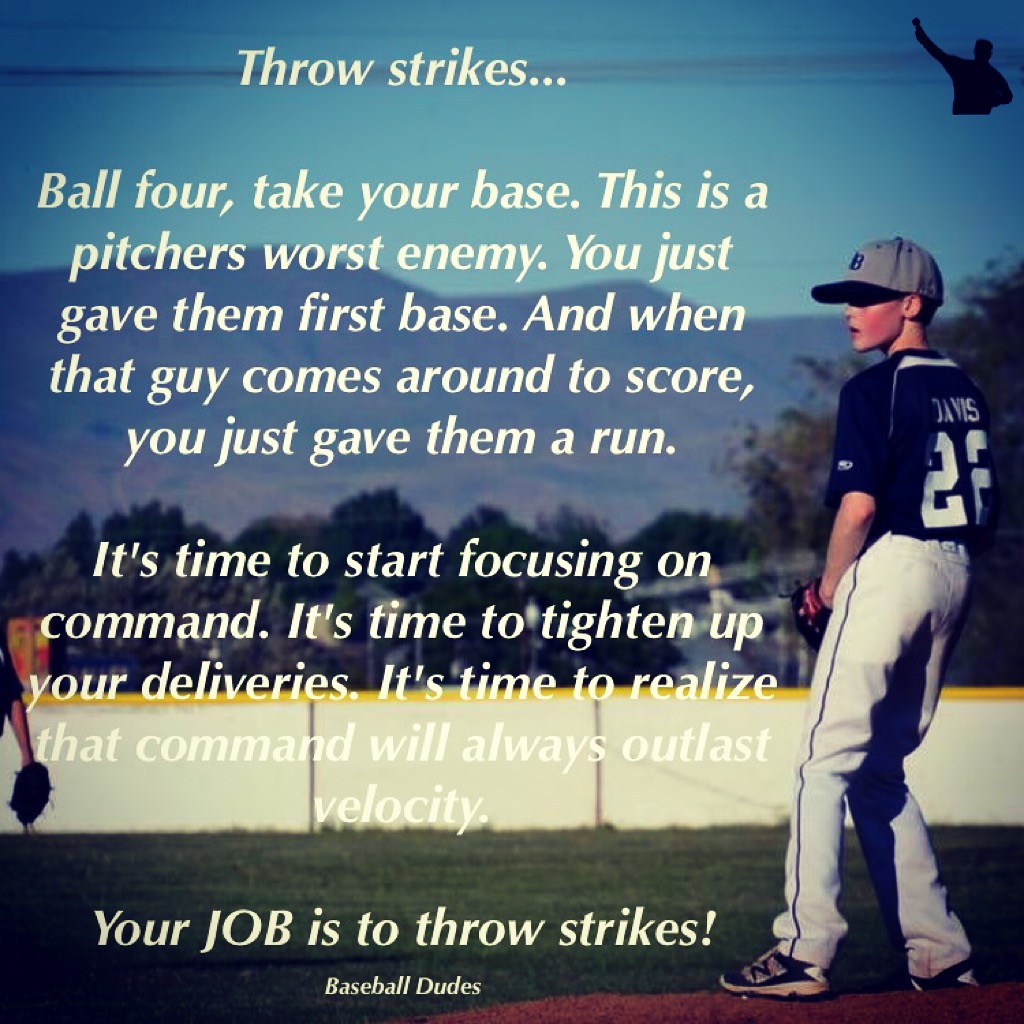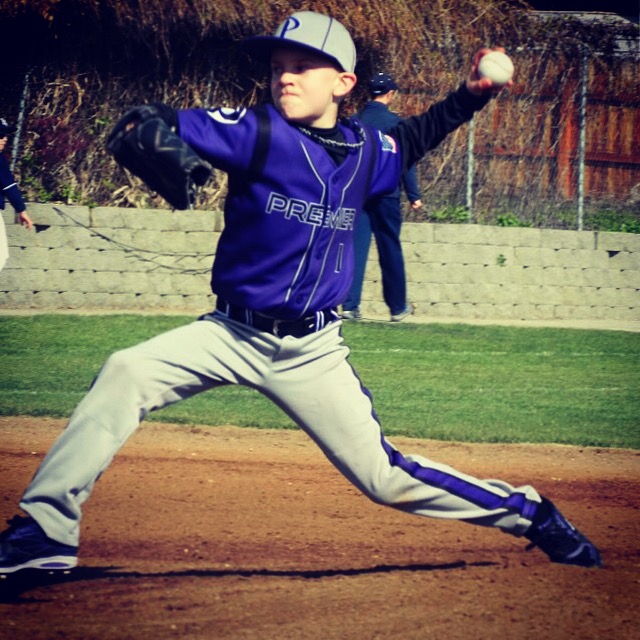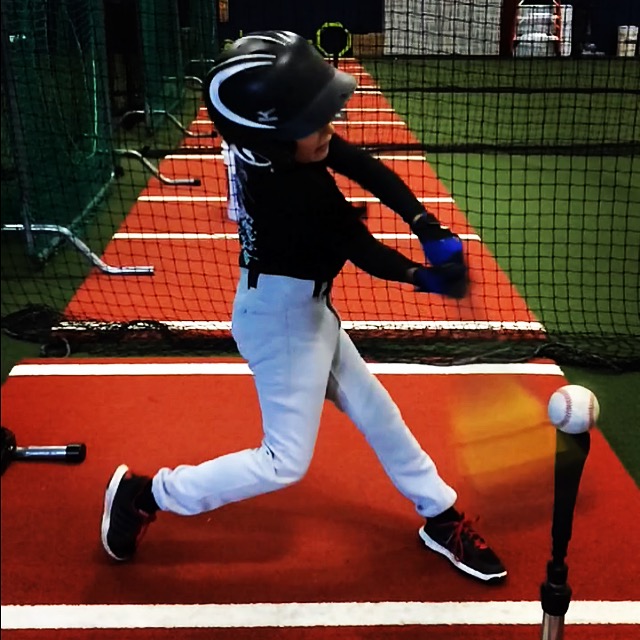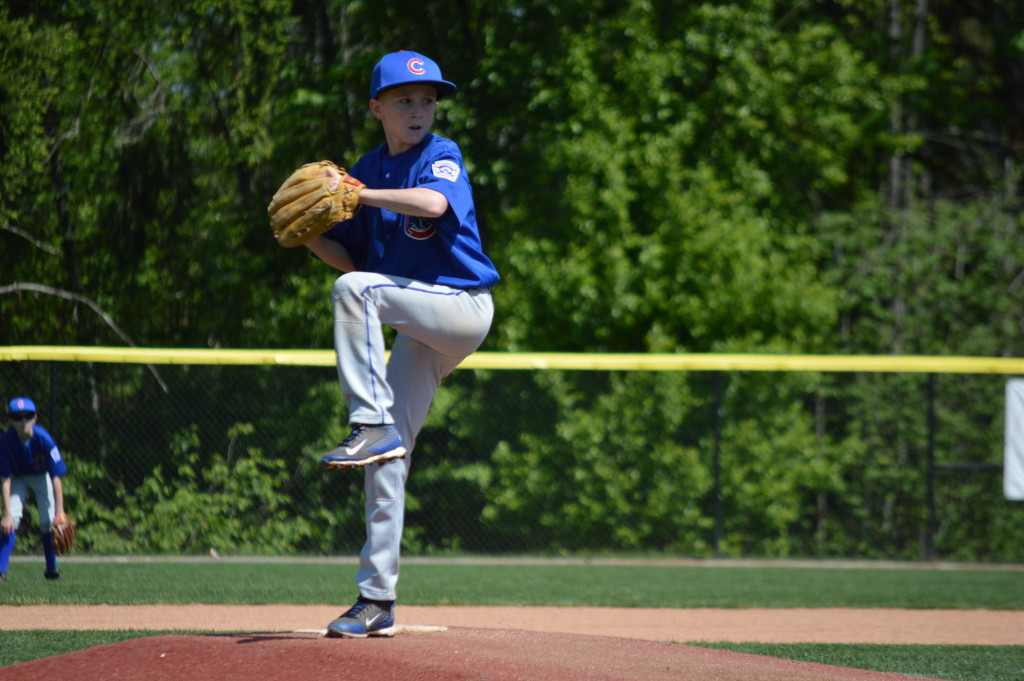 Tempo may also be referred to as “Pace” or “Speed” of the game. “Tempo” is controlled by the pitcher and catcher. Working quick may be the number one way to make a hitter uncomfortable, put the advantage in the pitchers hands and keep the flow of the game moving which also greatly benefits the focus of our defenders on the field. This can be judged by the amount of time between innings and pitches. At the professional level, we would shoot for 8-12 seconds from the release of one pitch to the release of the next. Obviously, this will be different when the ball is put in play, a mound visit is taken, etc.
Tempo may also be referred to as “Pace” or “Speed” of the game. “Tempo” is controlled by the pitcher and catcher. Working quick may be the number one way to make a hitter uncomfortable, put the advantage in the pitchers hands and keep the flow of the game moving which also greatly benefits the focus of our defenders on the field. This can be judged by the amount of time between innings and pitches. At the professional level, we would shoot for 8-12 seconds from the release of one pitch to the release of the next. Obviously, this will be different when the ball is put in play, a mound visit is taken, etc.
Hitters HATE to feel rushed. They want time to go through their routine. They want time to get comfortable in the box. Some can act as a human rain delay (just as some pitchers can act). Hitters hate nothing more than to get in the box, look up at the pitcher and see him already in the set position or already starting their delivery.
If a hitter has to call time out because of this, pitchers should take pride in that. You are doing and important part of your job by making him uncomfortable without even throwing a pitch! And if they have to do it multiple times, bingo…You are swimming in their head now. They are losing their focus. When they lose their focus, they lose their approach. When they lose their approach, the pitcher will win nearly every time.
When pitchers are taught this concept, taught this part of the mental game, it doesn’t matter their talent level, they will have an advantage and be able to take control of a game.
With that said, there are some coaching tactics and things young ball players simply aren’t being taught that can put the kibosh to the Tempo of a game in a matter of seconds…
1) Micro-managing during every pitch of the game. The whole team has to look in the dugout to see where to move, what pick off move to put on, what pitch to call. TEMPO KILLER
2) The pitcher and catcher not being on the same page. The catcher doesn’t know what the pitcher likes to throw in certain counts, thus the pitcher is constantly shaking off the catchers suggestion. Pitchers, put some faith in your catchers and remember that any pitch in any count can be effective as long as you execute it. Catchers, take time to talk to your pitchers and see what they like to do. Boys, we need to communicate better before the game and in-between innings. TEMPO KILLER
3) Pitchers walking around the mound between every pitch (sometimes necessary though to clear your head). TEMPO KILLER
4) Pitchers walking half way to home plate, after they throw a pitch, to catch the ball from the catcher and then having to walk, or jog, all the way back to the rubber. Personally, I have witnessed this being done and being taught more often than it should be, which is NEVER! The common reason for this is to protect the catchers arm or make a shorter throw for the catcher. Wrong reason guys. If the catcher has a hard time throwing the ball to the mound, then it’s our job to teach them how to throw properly. TEMPO KILLER
**After a pitcher throws a pitch, ideally, they are back peddling back up the mound and are on, or within one step from being back on, the rubber ready to get the next sign. This is pitching boys. This is how we take control of the game. This is how the best go about their business. This is what position players LOVE to play behind.
5) At the youngest of ages, Tempo proves to be a constant struggle. Finding kids that are fearless behind the plate and who have a sense of urgency to keep the ball in front and to go get it QUICKLY when it gets past them, is often hard to find AND hard to develop. We must take time to really give our young backstops a lot of attention on receiving, blocking and retrieving passed balls and wild pitches. If we fail to recognize the importance of this…TEMPO KILLER
Pitchers and Catchers…Have a plan. Be on the same page. Work quick. Be the first ones on the field after the third out is made. Jog to your positions. Get your warm up pitches done in a quick manner. Make it a point to make the hitter uncomfortable. Take pride in them needing to call timeout. Take pride in the other teams players and coaches getting frustrated with this. Don’t back down. This is YOUR game, OWN IT!!
 Chris Gissell (175 Posts)
Chris Gissell (175 Posts)Founder of Baseball Dudes. Blessed with three beautiful children and an amazing wife. Baseball is my life, after my family, and I love sharing what I have learned from it. Thanks for taking the time to view what we offer here at Baseball Dudes.
 We all love to see a hard thrower. Realistically, when they are younger, they can be the most effective pitchers. The hitters are scared, they tend not to swing, or you see late panic swings as the hitters are on their heels from the beginning.
We all love to see a hard thrower. Realistically, when they are younger, they can be the most effective pitchers. The hitters are scared, they tend not to swing, or you see late panic swings as the hitters are on their heels from the beginning.





 We talk a lot about helping the players develop game awareness. This is a big.
We talk a lot about helping the players develop game awareness. This is a big. I want to make you aware of some certain truths about your dreams, goals and your future.
I want to make you aware of some certain truths about your dreams, goals and your future. With the 3 day holiday weekend approaching (Memorial Day Weekend), there is a lot of baseball that’s going to be played across the nation.
With the 3 day holiday weekend approaching (Memorial Day Weekend), there is a lot of baseball that’s going to be played across the nation. I first experienced “Dead Arm” as a young professional. It’s painful. It’s annoying. If it gets bad enough, it feels like your arm will break at any moment with each throw. It can even wake you up at night. It’s not fun!!
I first experienced “Dead Arm” as a young professional. It’s painful. It’s annoying. If it gets bad enough, it feels like your arm will break at any moment with each throw. It can even wake you up at night. It’s not fun!! What does it mean to “Condition” an arm and why is it important?
What does it mean to “Condition” an arm and why is it important? There are plenty of different Change Up grips to try/use.
There are plenty of different Change Up grips to try/use.
 Tempo may also be referred to as “Pace” or “Speed” of the game. “Tempo” is controlled by the pitcher and catcher. Working quick may be the number one way to make a hitter uncomfortable, put the advantage in the pitchers hands and keep the flow of the game moving which also greatly benefits the focus of our defenders on the field. This can be judged by the amount of time between innings and pitches. At the professional level, we would shoot for 8-12 seconds from the release of one pitch to the release of the next. Obviously, this will be different when the ball is put in play, a mound visit is taken, etc.
Tempo may also be referred to as “Pace” or “Speed” of the game. “Tempo” is controlled by the pitcher and catcher. Working quick may be the number one way to make a hitter uncomfortable, put the advantage in the pitchers hands and keep the flow of the game moving which also greatly benefits the focus of our defenders on the field. This can be judged by the amount of time between innings and pitches. At the professional level, we would shoot for 8-12 seconds from the release of one pitch to the release of the next. Obviously, this will be different when the ball is put in play, a mound visit is taken, etc.  Any player can fall into a slump at any given time. No matter how good they are, at some point, it will happen.
Any player can fall into a slump at any given time. No matter how good they are, at some point, it will happen. Parents and Coaches…
Parents and Coaches… Both draw power from the lower half. Both need direction towards their target; Pitcher striding towards the catcher and the Hitter striding towards the Pitcher. Both use the hips to generate torque for the upper half to come through. Both need the upper half to stay closed as long as possible (until the stride foot hits the ground) for your upper half to come through with the most whip possible. They are both very similar to one another.
Both draw power from the lower half. Both need direction towards their target; Pitcher striding towards the catcher and the Hitter striding towards the Pitcher. Both use the hips to generate torque for the upper half to come through. Both need the upper half to stay closed as long as possible (until the stride foot hits the ground) for your upper half to come through with the most whip possible. They are both very similar to one another. As a young player, I have no idea how many times this happened to me. I do know, though, that it was more than I would have liked. But to this day, all those moments have helped mold me into the parent and coach that I strive to be today.
As a young player, I have no idea how many times this happened to me. I do know, though, that it was more than I would have liked. But to this day, all those moments have helped mold me into the parent and coach that I strive to be today. My last session of the day yesterday was with two of my High School students. Both are great kids, both are talented pitchers and both have the ability to play past HS, if they so desire.
My last session of the day yesterday was with two of my High School students. Both are great kids, both are talented pitchers and both have the ability to play past HS, if they so desire.